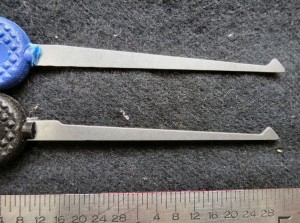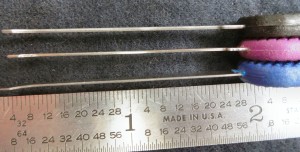Buy Quality, NOT Quantity…
I’m a sucker for shiny objects, especially when they’re displayed in a cool looking case and priced low. That was my criteria for my first lock pick kit. Nestled inside that black ballistic nylon case were the most highly chromed tools you’ve ever seen. The blue handles were beauteous, but as soon as I plucked out the first one I noticed how light they were. They had a cheap feeling. On my first use the chrome wore off the rake and the shaft bent. In the following hour the handles fell off of several more and I had broken two rakes and a hook – metal fatigue.
The pathetic part of this story is that I’m a mechanical engineer. I (supposedly) understood metallurgy, metal fatigue, failure due to cyclic loadings, and tensile stresses. I stupidly let the aesthetics and low price influence my decision to choose that kit. Oddly, of all the kits I’ve owned since, I remember the details of that crappy kit more vividly than any of the others – probably because I felt so ripped off and disappointed – both in the tools and myself.
Executive summary: Quality tools cost more but last a LOT longer.
Does that mean high quality lock picks will last forever? No. Metallurgy is metallurgy. The repetitive stress and flex we put on that thin piece of metal will eventually lead to metal fatigue and failure. Lots of people ask: How long do your picks last? This is usually after they break some of theirs. When I tell them that I break a pick every two weeks or so, they conclude that my picks are crap. They never ask what type of picks, who the manufacturer is, the type of material, or how frequently I use the picks. Yes, I break picks all the time but I use them for several hours every day. Over the years I’ve learned a few things about selecting picks and I’d like help you to avoid making the same stupid choices that I did. In fact, I felt so strongly about this that I started an entirely new series on my lock picking channel on YouTube that I call the “Lock Picker’s Consumer Reports”. To say its popular is an understatement. Let’s just say that it’s almost 100% fan funded.
There are several variables that determine how long your picks will last:
Materials
There are lots of materials that you could make pick from, but really only two that are durable and cost effective.
ASTM Type 301 Stainless Steel. At 250,000 psi tensile strength there are more durable metals that are used in aerospace but they are simply not economical to make picks out of. Standard 301 SS’s durability can be improved by heat treatments and cold rolling, raising the tensile strength to 280,000 psi. If you find a stronger or more durable material than this to make picks out of, you better be prepared to show me the alien spacecraft that you stole it out of. 301 SS shows fatigue by bending, allowing you to straighten it back out. However, once you’ve done that a few times, place an order for a replacement because catastrophic failure is imminent.
Carbon Spring Steel. There are a number of spring steels but ASTM 1074, 1080 and 1095 are the most common. Both have tensile strength below 80,000 psi which is plenty tough enough for picks. Spring steel doesn’t normally show fatigue until the moment of failure, snapping in the keyway.
Titanium. There are a number of different grades of Titanium but Grade 5 (also called Ti 6-4) is the most common and appropriate for pick construction. Titanium is light, strong, and non-magnetic. For some reason every Special Forces guy on Earth wants non-magnetic gear – and I have no idea why because any environment I go into where stealth is required will also find me carrying a firearm of some type, metal of course. So the applicability of non-magnetic picks in a tactical environment is negligible at best. Titanium is readily identifiable on X-Rays and airport metal detectors, so the non-magnetic properties are wasted there as well. Anyway, grade 5 titanium has a tensile strength of 1000 MPa, or about 145,000 psi, putting it somewhere between carbon spring steel and stainless. Titanium is more expensive than steels and is difficult to machine, requiring special tooling, lubricants and procedures to work with galling (smearing and clogging the cutting tool). This, of course, makes Titanium picks quite a bit more expensive than steel picks. I’ve had several titanium picks and didn’t really notice any performance difference when compared to steel. I did notice that it doesn’t seem to polish to quite as high a shine, but otherwise is identical in every respect to steel picks. Titanium picks DO rate higher on the cool factor though, so there’s always that to justify their price.
Substandard blends of Stainless Steel. Many manufacturers use lower grades of metal and can still advertise their picks are “stainless steel”. Manufacturers like these materials because they are cheaper, easier to machine, and resist corrosion. These are ASTM 302, 304 and 316 and have an average tensile strength of about 100,000 psi. These blends of SS are blended to be “ductile”, or bend without breaking. When constructing buildings or bridges, bending can be a good thing. In picks…not so much. Ductility is precisely the property we DON’T want. If your pick maker doesn’t specifically say he is using “301 Cold Rolled Stainless Steel”, then he’s using one of the cheaper, substandard blends.
If you’d like more technical information about different steels used in lock picks, please take a look at Christina Palmer’s paper on the subject.
Thickness
It should be obvious to the most casual observer that material thickness makes a tremendous difference in durability. Thicker = durable. Of course keyways dictate the maximum thickness so we have to balance thickness with accessibility.
In the photo the pick thicknesses from the top (black) are 0.025″, (purple) 0.018″, and (blue) 0.015″. All from Peterson International.
We really only have a few choices. Anything thinner than 0.012” is too limp and fragile to move pins without bending or breaking. Anything greater than 0.032 is too wide to fit into keyways. Most picks are available in 0.015”, 0.018”, 0.022”, 0.025”, and even higher. Where you live and what type of locks you work with dictate which thickness you’ll need. In North America most locks will accept the 0.025”. Using a thinner pick is pointless in those locks. In fact, when we choose a pick for our lock we want to use the thickest one that’ll fit into the keyway because it’s tougher, gives better feedback, and allows us to really pry the pins without damage. In Europe and the civilized part of the Universe (not including the US obviously), keyways are narrower and more paracentric. The 0.025” is simply too fat to fit into them – kind of like the average American trying to fit into an economy seat on Nippon Airlines. Not gonna happen. In Europe the best width is 0.015” or possibly 0.018”. So if you find yourself working on American locks, your picks will last much longer than if you were using 0.015” on European locks.
Profile
 The height of the pick shaft is important as well and most picks are offered in a “normal” profile and a “Euro” profile. The taller the profile, the more leverage abuse it can take. Again, keyways dictate which profile we have to use.
The height of the pick shaft is important as well and most picks are offered in a “normal” profile and a “Euro” profile. The taller the profile, the more leverage abuse it can take. Again, keyways dictate which profile we have to use.
The Euro profiles have a LOT less strength than “normal” profiles, but are necessary to reach into the back of their tighter keyways. Whenever possible, try to use the “normal” profile as I’ve found they last about twice as long as my Euros.
Pictured: Standard profile on top is stronger than the Euro profile shown on the bottom.
Frequency of Use
I think this is almost too obvious to mention but if you compare your breakage rate to someone else’s, be sure to ask how often they use their tools. I have a half diamond that’ll last for a million years because I never use it…
Picking Style
I’m an aggressive picker and never worry about breaking picks. I use picks for everything from really rough “bitch picking”, to prying off C-clips. I’ve used them as mini-pry bars, screw drivers, stabbing tools, probes – Once I even used a short hook to dig a hunk of shrapnel out of my forearm. There are no limits to how I’ve abused my picks and my broken tool drawer is evidence to that. If you baby your toys, store them in cushioned containers, and perform maintenance and frequent oiling… well, you get the picture. How you treat your tools makes a huge difference on their life.
There are some other considerations when buying picks, not just “shininess”.
Final Finishing. Virtually ALL picks need some shaping, sanding and polishing when they arrive. That’s because fine finishing is a manual task, requiring many minutes of effort. If you’re making 100,000 picks a day that adds up to 5,000 man-hours. At $1/hour (Chinese labor rates), that’s $5k. At U.S. minimum wage ($7.25) it would be more like $36k. That doesn’t even include the cost of sandpaper and polishing materials. Now you can see why manufacturers leave the finishing touches to the buyer. Money talks.
Handles are an important choice and can influence the final cost. The majority of picks are delivered with blank handles, i.e. just the metal shaft. Some are molded plastic, while others are dipped in rubber. Good ergonomic handles can make your picking a lot more comfortable as long as the vibration from the lock (feedback) isn’t muted by the handle material. I’ve found that hard molded plastic and once-dipped handles are a good balance of comfort and feedback. I’m not a fan of rubberized handles or thicker handles dipped more than once because the feedback is noticeably reduced.
